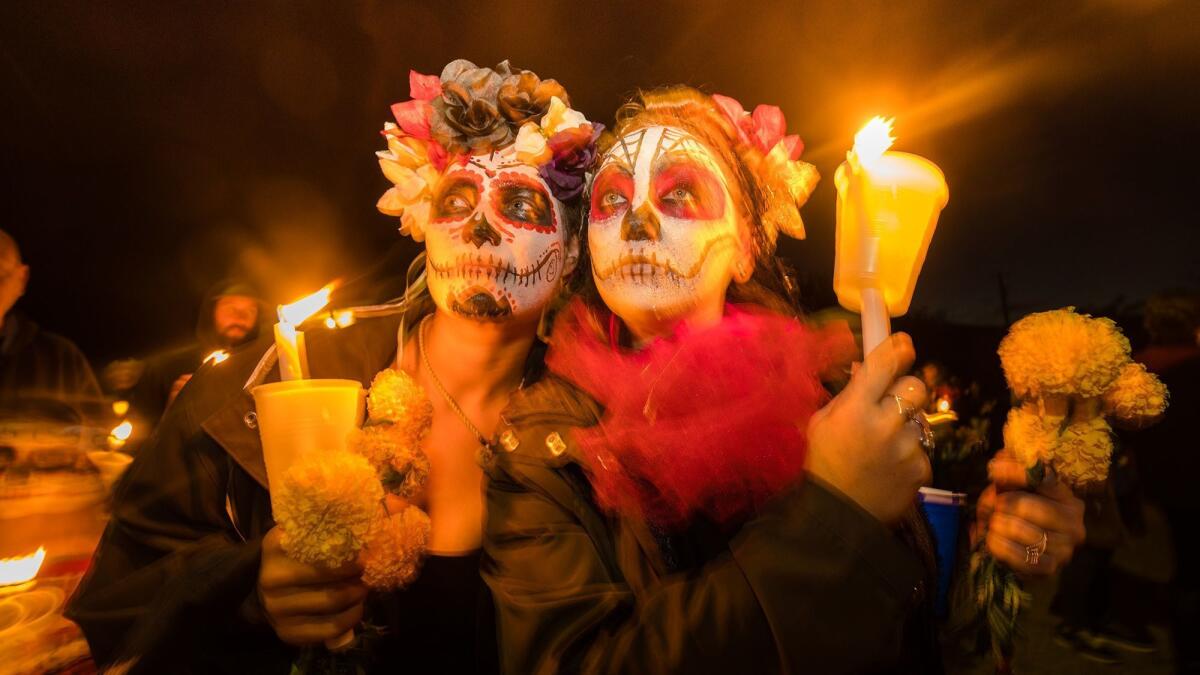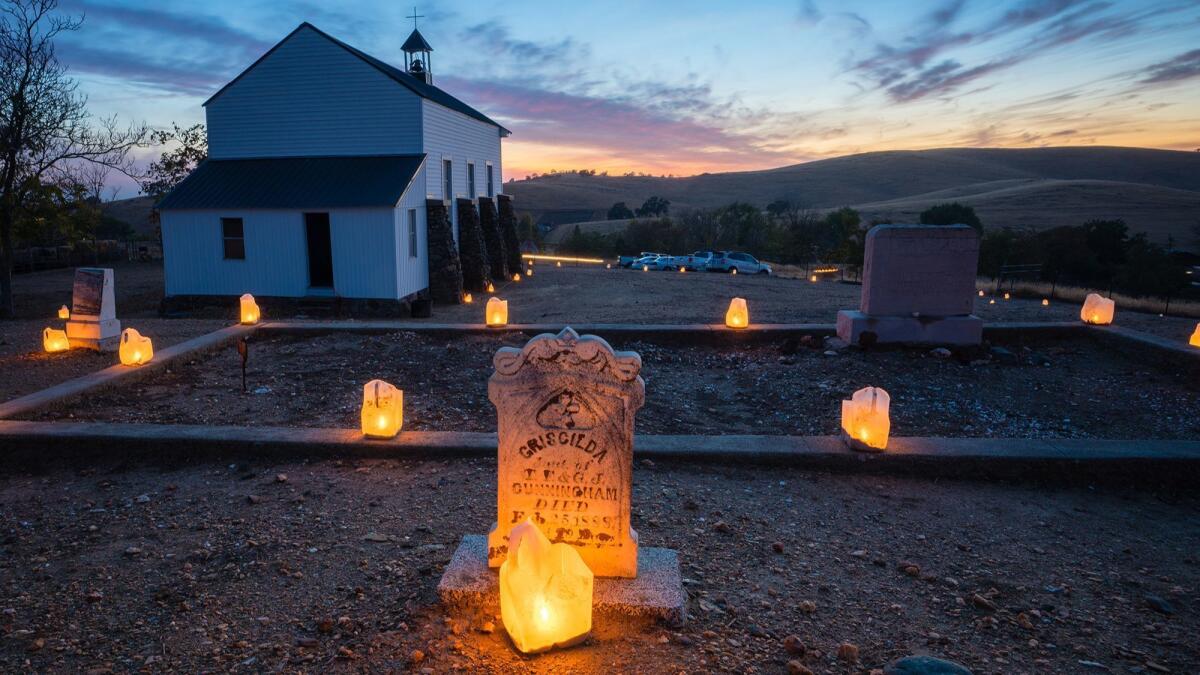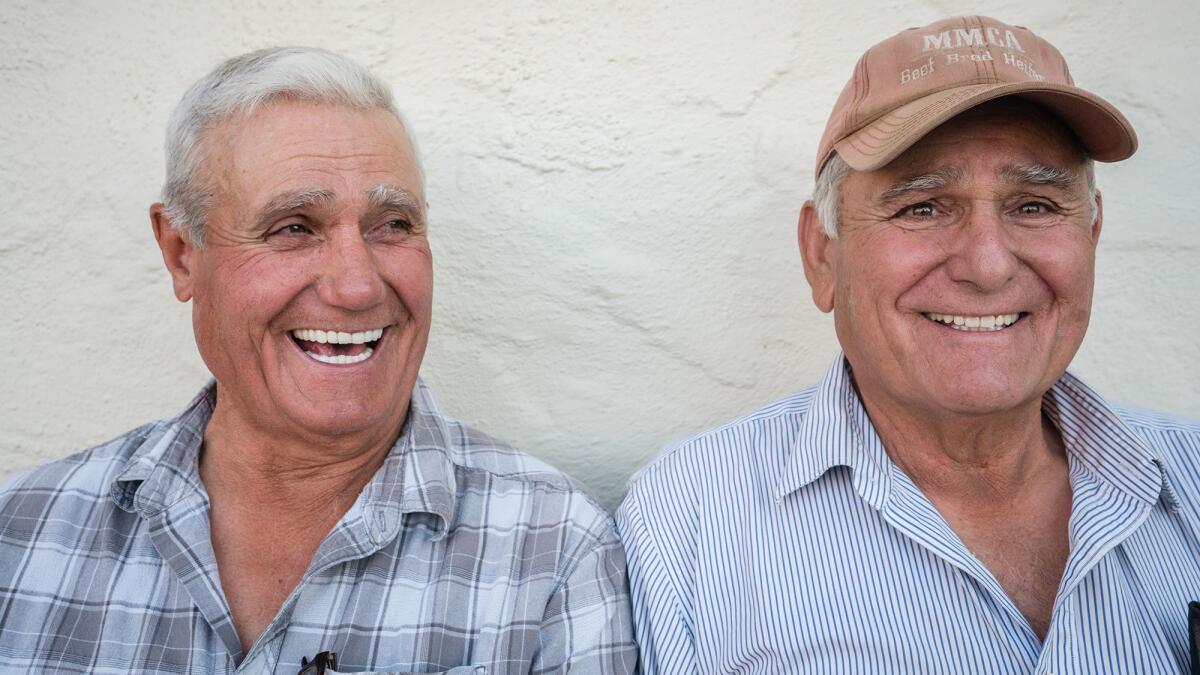Once a year, ghosts bring life to an old Gold Rush town

Reporting from Hornitos, Calif. — The rustle of dry grass and a lone wind chime are the only sounds. It’s quiet, like a ghost town.
Which it is.
Well, truth be told, Hornitos does have about 40 people living here. On weekends, Richie Ortiz, a rancher, mans Plaza Bar, ready for a game of Liar’s Dice with whoever might wander in.
Sometimes tourists detour on their way to Yosemite for a glimpse of California history, like the crumbling remnants of Domingo Ghirardelli’s first shop before he became a famous San Francisco chocolatier.
Ortiz, 67, will serve them a drink at the bar carved in 1852 and ring up their tab on the 1925 cash register. It’s been almost 70 years since his father bought the Plaza, which dates to when this was a Mexican village, before it was a notoriously lawless Gold Rush town, before it was a mining and sawmill town, where men either died young (the mines) or lost fingers, hands and arms (the mill).
All before it emptied out and became a place that holds California’s ghosts.
Once a year, the graveyard on the hill brings the town back to life.
“The cemetery is part of life here,” said Keri Ortiz, one of Ortiz’s nieces, an English professor at the junior college in Merced.
“Mrs. Turner is up there. When we were kids every Christmas, she’d give us a coffee can full of cookies with waxed paper between the layers. And Miss Eugenia who ran the general store is there. I never met her, but my dad did chores for her when he was a boy.
“My mom wants to be buried there because she says that way people will visit her at least once a year.”
On Nov. 2 to be exact, when candles are placed in cut off plastic milk bottles (850 of them) that line the path leading up to the gravesites. People from all over gather in Hornitos’ plaza and, carrying candles, head up the hill.
Día de los Muertos — Day of the Dead — is a tradition likely celebrated here when the town was founded by Mexicans driven out of their nearby village by miners. But during the Gold Rush, a rich vein was found nearby and Hornitos was overrun with people from everywhere. In the 1850s, it became known as the “wickedest spot in the motherlode,” thanks to a profusion of brothels, bars and shootouts.
The dead lost their day.

Then in the late 1800s, Dona Candelaria, a wealthy resident originally from Mexico, started the tradition of a procession to the cemetery, encouraging people of all religions and ethnicities to light a candle and remember.
The first stop every year is to leave a candle on the grave of Candelaria, who died in 1903.
This November, cotton-candy pink clouds turned rust and orange as the plaza filled with people. Neil Pauley, 79, was there with his daughters, sons-in-law and grandchildren who came from all over the state.
As a boy, Pauley lived with his grandparents in Hornitos. They are buried in the first grave to the left when you enter the cemetery. Elizabeth Rowe came here by wagon train from Springfield, Mo. James Rowe was an Irishman who grew up in Sonora, Mexico.
“You gotta remember, in those days, the Irish were shunned and discriminated against as much as the Mexicans. So it was something that he became U.S. Marshal Rowe,” Pauley said.
He was startled by how vivid and tangible being back in Hornitos made his memories.
“My grandmother would sit under that tree right there,” he said, pointing, “just quiet. I wasn’t invited and I wasn’t uninvited. I was welcome. And I’d sit by her peaceful-like.
“One day she said to me: ‘What do you hear? Don’t answer me out loud. Just listen to the morning.’ ”
Keri Ortiz’s 14-year-old niece Kamille Dean spent part of the evening selling Hornitos T-shirts to raise money for the Patrons club, which has sponsored the event since the 1940s. But she saved time to leave a candle at the grave of a man she had never met: Augie Marino, who had pushed her grandmother, Lulu, out of the path of a car when she was just a little girl.
Her other candle was for Manuela Ortiz, her great-grandmother who for decades had run the Plaza Bar. Manuela Ortiz had lost her memory to Alzheimer’s over the last decade and died this year.
“She held me as a baby. They told me stories about her since I was little. She was kind and welcoming, but she wouldn’t take back-sass from anyone. She was her own person,” Kamille said.
Soon the plaza and the bar were filled with some 900 people. Richie Ortiz and Kamille’s father, Derrek Dean, served drinks. Of course they had stocked up on Hornitos tequila. Some celebrants arrived with painted faces, in brilliant gowns and skeleton costumes. Women carried armfuls of marigolds.

For most of its history, the gathering in Hornitos centered on All Souls Day. It wasn’t considered a sad night, but a somber one. A mostly white town walked silently to the cemetery to pray for “the faithfully departed.”
Now, people with roots in Mexico drive up from the Central Valley, through gold foothills and past gray-green olive oak trees, to Hornitos, where they bring the traditions of Día de los Muertos. The remembrance isn’t just about praying for the departed, but inviting them back for a party.
But like All Souls’ Day, the Day of the Dead is a Catholic tradition that holds that each person is connected to something that stretches back before them — and will last after they’re gone.
Imelda Cervantes, 50, who worked the almond harvest that had just finished, wore a crown of braids and flowers, rustling skirts and face paint that was part skull, part hearts and flowers and Aztec symbols. She said she would be giving thanks for all of her ancestors.
Thomas Garcia, 61, a farmworker in a white cowboy hat and dress boots, said he was going to light a candle for Joaquin Murietta, the famed outlaw who once frequented Hornitos and symbolizes social justice for Mexican workers.
Greetings were exchanged all over the plaza.
“Father Stephen! How’s retirement?”
“Qué pasa?”
“You doing OK? Remember, nothing wrong with being single.”
When night fell, Father Michael Cox of St. Joseph’s Catholic Church in nearby Mariposa told the crowd that, despite a festive component, this was a sacred event and they should walk silently, in twos, up the hill.
The crowd moved, with the considerable din of a large group of people told to keep quiet. Mothers made hushing sounds louder than baby’s cries. Toddlers sang songs to themselves.
When the procession reached the steep hill before the graves, silence settled in. The church bell rang. A dog barked.
The sky was inky, the stars stamped with a brilliance seen only away from city lights. The tiny white church glowed, the long line of candles flickered and the Milky Way was a stripe of powdery light over the tombstones.
Pauley’s family placed photos, including one of him as a small child holding his grandmother’s hand, at his grandparents’ graves. There were offerings of food and drinks and flowers. They set up chairs around the gravesite, like a campfire. The grandchildren had painted faces and everyone was telling family stories.
Pauley stepped away from the circle. He stood still, looking at the stars. He seemed to be listening.
More to Read
Sign up for Essential California
The most important California stories and recommendations in your inbox every morning.
You may occasionally receive promotional content from the Los Angeles Times.











